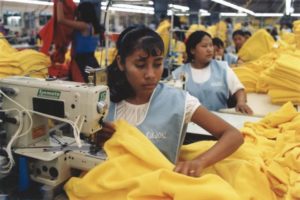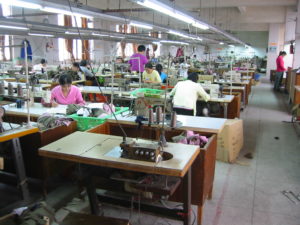Sweatshops of Today and Yesterday
The sweatshops of the past, as displayed by the Tenement Museum, were smaller, family-owned businesses. A small handful of people would work on making ready-made garments for a large department store, with the department store having commissioned each small sweatshop for mass production of one item. Eventually sweatshops became larger factories, slowly evolving into what we know them to be today. A peak example of modern day sweatshops are the sweatshops found in the deeply corrupt country of Bangladesh, especially their capital of Dhaka. “Dhaka is one of the poorest, densest and most populous cities in the world.” Bangladesh imports a good portion of all raw cotton imports globally for its huge textiles industry, which makes up nearly all of the country’s exports. It comes after only China in clothing exports. The minimum wage has been $0.35 an hour for a long time, until a recent increase to a still meager $0.42 an hour. There is poor infrastructure, such as poor electrical work in many of these factories. There is improper storage of chemicals like fabric dyes. Workers often risk serious injury and/or disability compared to non-factory jobs in the area. Dhaka is especially known for its building fires and collapses which have killed hundreds and even thousands of factory workers. This has been compared to the 1911 Triangle Shirtwaist Factory fire, except that event resulted in reform, while many of these events have inspired much change.

Sweatshops of the past are very similar to sweatshops of today in terms of the poor conditions and infrastructure, frequent injury and accidents, low pay for workers, and common usage by large, affordable ready-made clothing brands. However the difference today is that sweatshops are no longer as prominent in wealthy, economically powerful countries. Sweatshops are most prominent in countries that are poorer and have much smaller economies. The developed countries still benefit from sweatshop labor, but they can afford to save their own population from the sweatshops while forcing it onto countries who can not afford the same privileges for their populations. The sweatshops of today are also often on much larger scales, with more technology than the sweatshops of the past. They can also produce larger quantities and varieties of products than the sweatshops of the past ever could.

Sweatshops hold no benefit for these workers, seeing as work outside the factories that has similar pay, at least in Bangladesh, has less hours and much less risk of injury or disability. Insatiable consumerism demands low prices and cheap goods, but the cost of that mindless materialism is the exploitation of people who are given little other option. We are responsible for how important this harmful industry has become to Bangladesh, and we are responsible for how the body count that the textile industry has collected there. It is up to us to hold these large clothing brands accountable.
Volodzko, David. “Bangladesh Is Burning And Sweatshops Are The Fuel.” Forbes, Forbes Magazine, 26 Mar. 2019, www.forbes.com/sites/davidvolodzko/2019/03/05/bangladesh-and-the-fire-next-time/#5147c1ad2ca1.